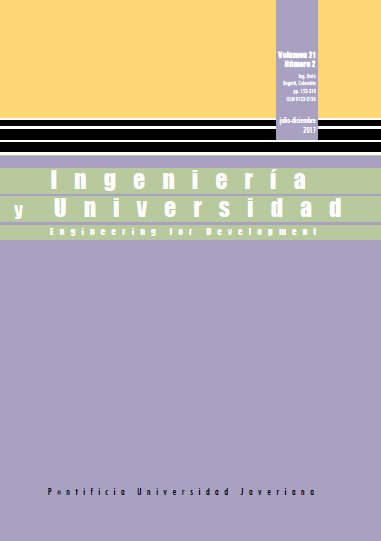Recovering spectral images from compressive measurements using designed coded apertures and Matrix Completion Theory
##plugins.themes.bootstrap3.article.details##
Introducción: Compressive spectral imaging (CSI) captures spectral information at various spatial locations of a spectral image with few compressed projections. Traditionally, the original scene is recovered by assuming sparsity in some known representation basis. In contrast, the matrix completion techniques (MC) rely on a low-rank structure that avoids using any known representation basis. The coded aperture snapshot spectral imager (CASSI) is a CSI optical architecture that modulates light by using a coded aperture with a pattern that determines the quality of reconstruction. The objective of this paper is to design optimal coded aperture patterns when MC is used to recover a spectral scene from CASSI measurements. Metodología: The patterns are attained by maximizing the distance between the translucent elements, which become more precise measurements given the MC constraints. Resultados: Simulations from different databases show an average improvement of 1 to 9 dBs when the designed patterns are used compared to the conventional random and complementary patterns. Discusión y conclusiones: The proposed approach solves an integer optimization problem with a complexity that is commonly NP-hard but that can be reduced with proper relaxation. Finally, an effective alternative method using coded apertura patterns for MC to solve the inverse compressive spectral imaging problem is presented. for MC to solve the inverse compressive spectral imaging problem is presented.
Matrix Completion, Spectral Imaging, Optimization problems, Compressive Sensing, Coded apertures.Teoría de estimación de elementos de matrices incompletas, Imágenes espectrales, Problema de optimización, Muestreo Comprimido, Aperturas codificadas.
[2] U. Heiden, A. Iwasaki, A. Müller, M. Schlerf, T. Udelhoven, K. Uto, and J. Chanussot, “Foreword to the special issue on hyperspectral remote sensing and imaging spectroscopy,” IEEE Journal of Selected Topics in Applied Earth Observations and Remote Sensing, vol. 9, pp. 3904-3908, 2016.
[3] C. Cucci, J. Delaney, and M. Picollo, “Reflectance hyperspectral imaging for investigation of works of art: old master paintings and illuminated manuscripts,” Accounts Chem. Res., vol. 49, no. 10, pp. 2070-2079, 2016.
[4] M. Pawlowski, J. Dwight, T. Nguyen, and T. Tkaczyk, “High speed image mapping spectrometer for biomedical applications,” In Bio-Optics: Design and Application, pp. BoW4A-2, 2017.
[5] D. J. Brady, Optical Imaging and Spectroscopy. New York: John Wiley and Sons, 2009.
[6] L. Galvis, H. Arguello, and G. Arce, “Coded aperture design in mismatched compressive spectral imaging,” Appl. Optics, vol. 54, pp. 9875–9882, 2015.
[7] D. Kittle, K. Choi, A. Wagadarikar, and D. Brady, “Multiframe image estimation for coded aperture snapshot spectral imagers,” Appl. Optics, vol. 49, no. 36, pp. 6824–6833, 2010.
[8] G. Arce, D. Brady, L. Carin, H. Arguello, and D. Kittle, “Compressive coded apertura spectral imaging: an introduction,” IEEE Signal Processing Magazine, vol. 31, no. 1, pp.105–115, 2014.
[9] C. Correa, H. Arguello, and G. Arce. “Spatiotemporal blue noise coded aperture design for multishot compressive spectral imaging,” J. Opt. Soc. Am., vol. A, no. 33, pp. 2312–2322, 2016.
[10] H. Rueda, H. Arguello, and G. Arce, “DMD-based implementation of patterned optical filter arrays for compressive spectral imaging,” J. Opt. Soc. Am., vol. A, no. 32, pp. 80-89, 2015.
[11] H. Arguello and G. Arce, “Restricted isometry property in coded aperture compressive spectral imaging,” In IEEE Statistical Signal Processing Workshop, pp. 716–719, 2012.
[12] H. Arguello and G. Arce, “Rank minimization code aperture design for spectrally selective compressive imaging,” IEEE T. Image Process., vol. 22, no. 3, pp. 941–954, 2013.
[13] E. Candes and B. Recht, “Exact low-rank matrix completion via convex optimization,” In Forty-Sixth Annual Allerton Conference, pp. 806–812, 2008. doi: 10.1109/ALLERTON. 2008.4797752
[14] B. Recht, “A simpler approach to matrix completion,” The Journal of Machine Learning Research, vol. 12, no. 10, pp. 3413–3430, 2011.
[15] J. Cai, E. Candes, and Z. Shen, “A Singular value thresholding algorithm for matrix completion,” SIAM J. Optimiz., vol. 20, no. 4, pp. 1956–1982, 2010.
[16] R. Sun and Z. Luo, “Guaranteed matrix completion via non-convex factorization,” IEEE T. Inform. Theory, vol. 62, no. 11, pp. 6535-6579, 2016.
[17] A. Waters, A. Sankaranarayanan, and R. Baraniuk, “SpaRCS: recovering low-rank and sparse matrices from compressive measurements,” Neural Information Processing Systems, NIPS 2011. [Online]. Available: http://perception.csl.illinois.edu/matrix-rank/Files/sparcs_nips.pdf
[18] Y. Zhang, B. Du, L. Zhang, and S. Wang, “A low-rank and sparse matrix decompositionbased Mahalanobis distance method for hyperspectral anomaly detection,” IEEE T. Geosci. Remote, vol. 54, no. 3, pp. 1376-1389, 2016.
[19] G. Yuan, and B. Ghanem, “A proximal alternating direction method for semi-definite rank minimization,” in AAAI, pp. 2300-2308, 2016.
[20] J. Lee, and Y. Choe, “Low rank matrix recovery via augmented Lagrange multiplier with nonconvex minimization,” in IEEE 12th Image, Video, and Multidimensional Signal Processing Workshop (IVMSP), pp. 1-5, 2016.
[21] R. Keshavan and S. Oh, “A gradient descent algorithm on the Grassman manifold for matrix completion,” arXiv preprint arXiv, 0910.5260v2, 2009.
[22] K. Lee and Y. Bresler, “Admira: atomic decomposition for minimum rank approximation,” IEEE T. Inform. Theory, vol. 56, no. 9, pp. 4402–4416, 2010.
[23] Z. Wen, W. Yin, and Y. Zhang, “Solving a low-rank factorization model for matrix completion by a nonlinear successive overrelaxation algorithm,” Mathematical Programming Computation, vol. 4, no. 4, pp. 333–361, 2012.
[24] Y. Zhang and Z. Wen, “Low-rank matrix fitting,”2009. [Online]. Available: http://lmafit.blogs.rice.edu. Accessed: 15 Jan 2016.
[25] C. V. Correa, H. Arguello, and G. R. Arce, “Compressive spectral imaging with coloredpatterned detectors,” in IEEE International Conference on Acoustic, Speech and Signal Processing (ICASSP), pp. 7789–7793, 2014.
[26] F. Yasuma, T. Mitsunaga, D. Iso, and S. Nayar. “Generalized assorted pixel camera: postcapture control of resolution, dynamic range and spectrum,” Technical report, 2008.


